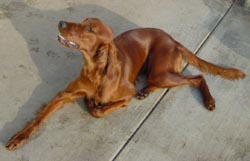This
fixation with eating or rolling
in noxious material is likely
to affect your family's respect
and affection for your dog over
time; at least the hugs and
wet kisses! Rolling is hypothesized
to come from the instinct of
predators to roll in a carcass
to hide their own scent from
their prey during the hunt.
Current dogs who are not hunting
are probably responding to this
deep instinct, "It seemed
like the right thing to do at
the time."
|
Rolling
is hypothesized to come
from the instinct of predators
to roll in a carcass to
hide their own scent from
their prey during the hunt.
|
That
may be the original incentive,
but we have to be careful a
pattern doesn't develop.
When a dog does something that
repels  people,
the people react. Like an errant
child, the dog finds out how
to get a reaction. The more
stinky, the bigger the reaction.
The bad behavior becomes attention
seeking behavior.
people,
the people react. Like an errant
child, the dog finds out how
to get a reaction. The more
stinky, the bigger the reaction.
The bad behavior becomes attention
seeking behavior.
If
you are confident there is no
attention seeking component,
you must keep the dog on a leash,
or be prepared for the occasional
bath after the fact. Another
alternative is to employ a professional
trainer to try to get to the
true motivation, and to design
a behavior modification plan.
If
you think attention seeking
might be a component, here are
some suggestions. If you don't
already own them, buy at least
a dozen assorted Kong toys or
other new indestructible chew
toys. Begin to install very
tasty food inserts, varying
them, and washing and replacing
often. Have several around outside,
so they are easy to find. If
he likes to fetch, throw them,
and praise any attempt at return.
When
on your walks, if he is "oral"
by nature, encourage him to
carry a Kong or tennis ball
in his mouth constantly. Whenever
he does, give more positive
attention for this, than he
ever got negative attention
for funky stuff. Make it his
job to carry a toy, which reduces
other stuff into his mouth,
and gives you a visual reminder
to initially give almost a praise
per step to communicate how
clever he is. If he drops it,
make it a game to try to find
it, and play keep away for a
few seconds, until he has to
SIT to get it back.
If
you see he is going to go for
some foul target, call him to
you, or whoop it up and run
the opposite direction to get
him to follow. Once he runs
toward you, call COME and praise
like this is his "second
coming." This is where
you say SIT (working for the
reward makes it more valuable),
then pull the smaller Kong from
your pocket and if he will take
it in his mouth, act like he
just won the Pulitzer. If he
still hasn't learned SIT, it
is time to call in a professional
trainer to help with the basics.
In
general, when out on a walk,
begin calling him to you when
he is NOT focused on a find,
and get him to COME and SIT
for praise. Try for 30 times
a day. Like weight lifting,
repetition will build the COME
muscle between his ears, and
if he is heading off toward
something bad, call him early,
and insist he come. Consider
having him drag a 20 foot rope
you can step on if he ignores
your COME Instruction. If he leaves
a prize to COME to you instead,
ignore the recent bad behavior,
and praise the current good.
If
he gets to something bad and
is already munching, simply
tell him NO (without a big scene),
take it away, and be ready to
substitute something positive.
If you don't have a substitute
chew toy, a second choice is
to practice COME, SIT and give
him a dog treat if you have
one. Then back up, and repeat
the COME, SIT a few times for
practice. If no treat is available,
do the COME, SIT but with "heavy
petting" instead of the
treat. If he only works for
treats, begin to treat reward
every other, then every third
or fourth positive act. If you
just don't have Kongs, treats,
time or energy to redirect him
this time, ignore the negative
behavior; just don't give attention
for the wrong thing unless prepared
to give WAY more attention for
doing the right thing.